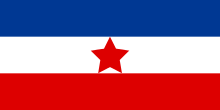Republic of Užice
| Republic of Užice | |||||
| Užička Republika Ужичка република | |||||
| Partisan Liberated Territory | |||||
| |||||
|
| |||||
| Anthem None specified a | |||||
| Capital | Užice | ||||
| Languages | Serbo-Croatian (de facto Užičan dialect) | ||||
| Government | Socialist republic | ||||
| Chairmanb | Dragojlo Dudić | ||||
| General Secretaryc | Josip Broz Tito | ||||
| Legislature | Central Committee for Liberated Territory | ||||
| Historical era | World War II | ||||
| • | Partisan arrival in Užice | July 28, 1941 | |||
| • | Battle of Drežnik | August 18, 1941 | |||
| • | German ultimatum | September 10, 1941 | |||
| • | Liberation of Užice | September 24, 1941 | |||
| • | Battle of Kadinjača | November 29, 1941 | |||
| • | Conquered | December 1, 1941 | |||
| a. | Hey, Slavs and other Partisan songs were unofficially used. | ||||
| b. | Chairman of the Main Peoples Council of Serbia. | ||||
| c. | General Secretary of the Communist Party of Yugoslavia and Commander in Chief of the Partisans. | ||||
The Republic of Užice (Serbo-Croatian: Užička Republika/Ужичка република) was a short-lived liberated Yugoslav territory and the first liberated territory in World War II Europe, organized as a military mini-state that existed in the autumn of 1941 in occupied Yugoslavia, more specifically the western part of the Territory of the Military Commander in Serbia[Note 1]. The Republic was established by the Partisan resistance movement and its administrative center was in the town of Užice.
Borders
The Republic of Užice comprised a large portion of western part of the occupied territory and had a population of more than 300,000 (according to another source, nearly one million [3]). It was located between the Valjevo–Bajina Bašta line in the north, the river Drina on the west, the river Zapadna Morava in the east, and the Raška region to the south.
Different sources provide differing information about the size of the republic: according to some sources, it included 15,000[3] or 20,000[4] square kilometres.
History
The government was made of "people's councils" (odbori), and the Communists opened schools and published a newspaper, Borba (meaning "Struggle"). They even managed to run a postal system and around 145 km of railway and operated an ammunition factory from the vaults beneath the bank in Užice.[5]
In November 1941, in the First anti-Partisan offensive, the German troops occupied this territory again, while the majority of Partisan forces escaped towards Bosnia, Sandžak and Montenegro, re-grouping at Foča in Bosnia.
End
The leftist policy then pursued by Josip Broz Tito substantially contributed to the defeat of the partisans in the Republic of Užice.[6] Because of the pro-fascist Serbian propaganda which described the partisans as being led by foreigners,[7] the population of Serbia turned against the uprising and against the communist insurgents. At the beginning of December 1941[8] the communists moved from Serbia to Bosnia (nominally part of the NDH) and joined their comrades who had already left Montenegro.[9]
In popular culture
The 1974 Yugoslav partisan feature film The Republic of Užice covers the events surrounding the existence of the Republic of Užice.
See also
References
- Notes
- Footnotes
- ↑ Hehn (1971), pp. 344-373
- ↑ Pavlowitch (2002), p. 141
- 1 2
- ↑
- ↑ Misha Glenny, The Balkans, 1999, p. 487
- ↑ Banac 1988, p. 81.
- ↑ http://www.crvenakritika.org/istorija/76-propaganda-u-okupiranoj-srbiji
- ↑ Jelić, Ivan; Strugar, Novak (1985). War and revolution in Yugoslavia, 1941-1945. Socialist Thought and Practice. p. 122.
Partisan Detachments of Yugoslavia and the leaderships of the national liberation movement withdrew from Serbia early in December 1941
- ↑ Pavlowitch 2002, p. 147: "When repression burst the bubble of optimism, the popular mood in Serbia also turned against the insurgency and those who wanted to carry on with revolution... The partisan crossed into nominally NDH territory, where they joined up with their comrades who had left Montenegro. "
- Bibliography
- Banac, Ivo (1988). With Stalin Against Tito: Cominformist Splits in Yugoslav Communism. Cornell University Press. ISBN 0-8014-2186-1.
- Hehn, Paul N. (1971). "Serbia, Croatia and Germany 1941-1945: Civil War and Revolution in the Balkans". Canadian Slavonic Papers. University of Alberta. 13 (4): 344–373. Retrieved 8 April 2012.
- Pavlowitch, Stevan K. (2002). Serbia: the History behind the Name. London: C. Hurst & Co. Publishers. ISBN 978-1-85065-476-6.
- Pavlowitch, Stevan K. (2002). Serbia: The History Behind the Name. C. Hurst & Co. Publishers. ISBN 978-1-85065-477-3.
Further reading
- Venceslav Glišić, Užička republika, Belgrade, 1986.
- Jovan Radovanović, 67 dana Užičke republike (67 дана Ужичке републике), Belgrade, 1972. (1st edition, 1961.)
- Boško N. Kostić, Za istoriju naših dana, Lille, France, 1949.
External links
- Modern Serbia - Revolution and the antifascist struggle at Encyclopædia Britannica.
- Opština Užice
- Western Serbia
